Over the recent weekend in Chicago, gun violence surged dramatically, resulting in the shooting of at least 21 individuals, five of whom tragically lost their lives. This wave of violence unfolded amid a broader discussion regarding public safety in the city, particularly under the leadership of young Mayor Brandon Johnson, a Democrat who has faced significant scrutiny due to ongoing crime challenges. Reports from ABC 7 detailed the timeline of these incidents, which began on Saturday evening when a 32-year-old male was shot multiple times in the chest by two assailants in the neighborhood of Ellis Avenue. Despite being rushed to a medical facility, he succumbed to his injuries shortly after arrival.
The violence continued into the early hours of Sunday with the second fatal shooting, in which a 36-year-old man was shot in the chest around 2:00 a.m., and, like the previous victim, he did not survive despite medical intervention. Later that morning, at approximately 4:00 a.m., another shooting claimed a 23-year-old, found severely wounded on S. Saginaw Avenue, who also ultimately died at the hospital. The escalating violence culminated later on Sunday with a shooting at the Morse CTA Red Line stop, where a 27-year-old was shot outside by a driver from an SUV, leading to his death shortly thereafter.
Perhaps most concerning was the final fatal shooting of the weekend, where a 17-year-old boy was killed and a 14-year-old girl injured in gunfire while walking together near 56th Street and Maplewood Avenue. These tragic events highlighted the severity and randomness of gun violence in the city, striking individuals regardless of age and raising questions about community safety measures. Local news outlets, including CBS News, have reported on this incident, emphasizing the need for effective strategies to combat the ongoing cycle of violence affecting the youth in the area.
Statistical data reveals that, as of 2024, Chicago has seen a harrowing total of 462 homicides, underscoring a troubling trend in urban violence that challenges policymakers and citizens alike. The escalating death toll has sparked discussions among residents and leaders about the effectiveness of current policing methods, community programs, and potential legal reforms regarding gun ownership and usage. As public officials seek to address these issues, the heartbreaking toll of lost lives will inevitably continue to loom large over the discourse surrounding crime in Chicago.
Amidst the backdrop of these violent occurrences, figures like AWR Hawkins provide analysis on the implications of gun legislation and the Second Amendment, framing the situation within a larger national discussion on gun rights and public safety. Hawkins, a columnist for Breitbart News, has consistently highlighted the complexities surrounding gun ownership in America, advocating for both rights and responsibility. With public trust in law enforcement wavering and demands for more substantial gun control growing louder, the dialogue surrounding effective solutions is becoming ever more urgent and layered.
As the city moves forward, the challenge remains not only to reduce the alarming rates of violence but to foster a climate of safety and community resilience. This involves a collaborative effort among city officials, law enforcement, and community organizations to develop comprehensive approaches that address both the symptoms and root causes of gun violence. Ongoing engagement with community members, improved access to mental health services, and innovative programs aimed at youth empowerment may offer pathways forward. Ultimately, the heartbreaking events of the recent weekend serve as stark reminders of the work that lies ahead to reclaim safety for all Chicago residents.

